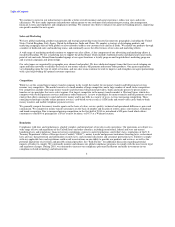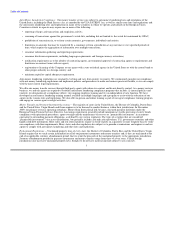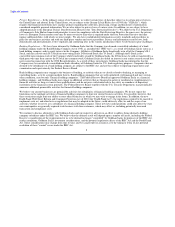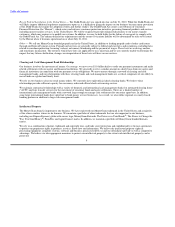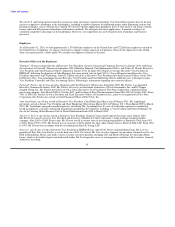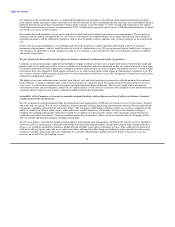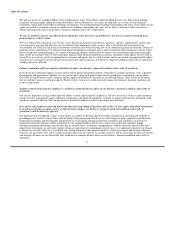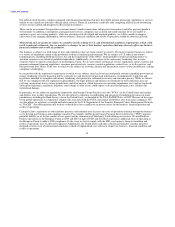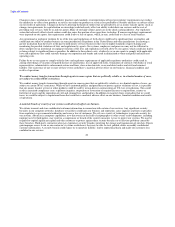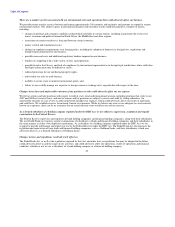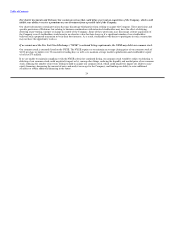MoneyGram 2010 Annual Report Download - page 19
Download and view the complete annual report
Please find page 19 of the 2010 MoneyGram annual report below. You can navigate through the pages in the report by either clicking on the pages listed below, or by using the keyword search tool below to find specific information within the annual report.
Table of Contents
Our official checks outsourcing business is conducted through financial institutions. Our official check financial institution customers
issue official checks and money orders and remit to us the face amounts of those instruments the day after they are issued. MoneyGram is
liable for payment on all of those instruments except cashier's checks. As of December 31, 2010, we had credit exposure to our official
check financial institution customers of approximately $375.7 million in the aggregate spread across 1,400 financial institutions, of which
one owed us in excess of $15.0 million.
We monitor the creditworthiness of our agents and official check financial institution customers on an ongoing basis. There can be no
assurance that the models and approaches we use to assess and monitor the creditworthiness of our agents and official check financial
institution customers will be sufficiently predictive, and we may be unable to detect and take steps to timely mitigate an increased credit
risk.
In the event of an agent bankruptcy, we would generally be in the position of creditor, possibly with limited security or financial
guarantees of performance, and we would therefore be at risk of a reduced recovery. We are not insured against credit losses, except in
circumstances of agent theft or fraud. Significant credit losses could have a material adverse effect on our business, financial condition
and results of operations.
We face fraud risks that could adversely affect our business, financial condition and results of operations.
Criminals are using increasingly sophisticated methods to engage in illegal activities such as paper instrument counterfeiting, fraud and
identity theft. As we make more of our services available over the Internet and other unmanned media, we subject ourselves to new types
of consumer fraud risk because requirements relating to customer authentication are more complex with Internet services. Certain former
retail agents have also engaged in fraud against consumers or us, and existing agents could engage in fraud against consumers or us. We
use a variety of tools to protect against fraud; however, these tools may not always be successful. Allegations of fraud may result in fines,
settlements and litigation expenses.
The industry has come under increasing scrutiny from federal, state and local regulators in connection with the potential for consumer
fraud. Negative economic conditions may result in increased agent or consumer fraud. If consumer fraud levels involving our services
were to rise, it could lead to regulatory intervention and reputational and financial damage. This, in turn, could lead to government
enforcement actions and investigations, reduce the use and acceptance of our services or increase our compliance costs and thereby have
a material adverse impact on our business, financial condition and results of operations.
An inability of the Company or its agents to maintain adequate banking relationships may adversely affect our business, financial
condition and results of operations.
We rely on domestic and international banks for international cash management, ACH and wire transfer services to pay money transfers
and settle with our agents. We also rely on domestic banks to provide clearing, processing and settlement functions for our paper-based
instruments, including official checks and money orders. The Company's relationships with these banks are a critical component of our
ability to conduct our official check, money order and money transfer businesses. An inability on our part to maintain existing or
establish new banking relationships sufficient to enable us to conduct our official check, money order and money transfer businesses
could adversely affect our business, financial condition and results of operations. There can be no assurance that the Company will be
able to establish and maintain adequate banking relationships.
We rely on a primary international banking relationship for international cash management, ACH and wire transfer services. Should we
not be successful in maintaining a sufficient relationship with one of the limited number of large international banks that provide these
services, we would be required to establish a global network of banks to provide us with these services. This could alter the pattern of
settlement with our agents and result in our agent receivables and agent payables being outstanding for longer periods than the current
remittance schedule, potentially adversely impacting our cash flow. Maintaining a global network of banks, if necessary, may also
increase our overall costs for banking services.
16


